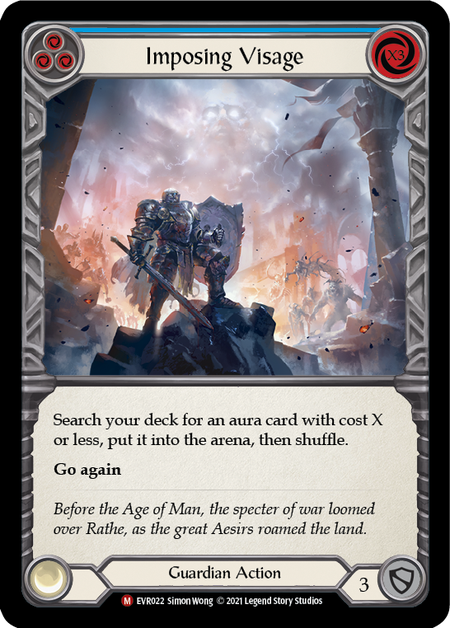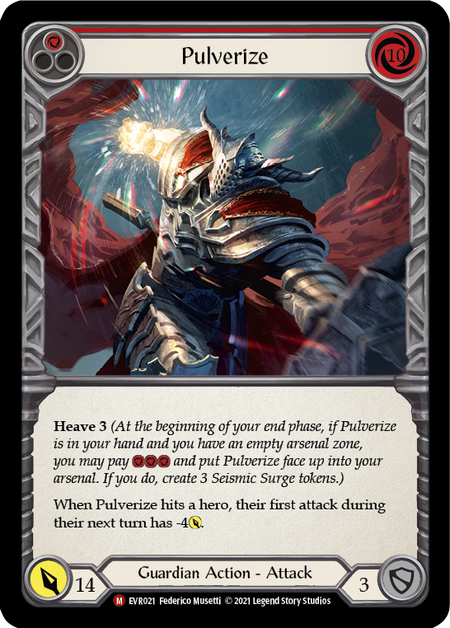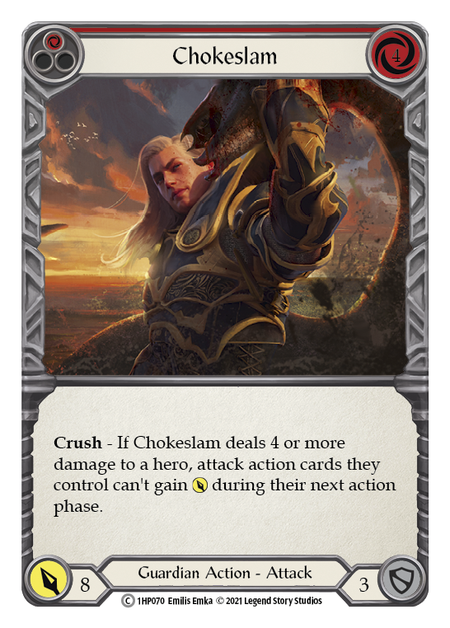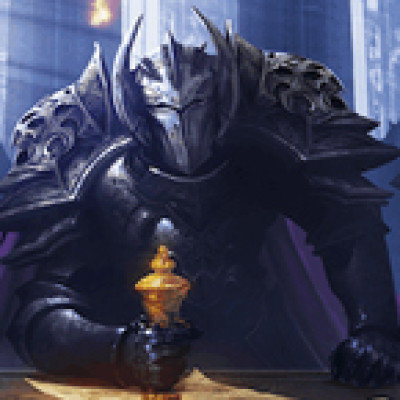Everyone knows that Bravo, Showstopper is a hero built on consistency. Around 60% of your cards will block for 3, pitch for 3, and cost (at least) 3. (The remaining 40% will ruin your opponent’s day.)
But what people often underestimate is just how adaptable Bravo can be to every situation. By siding in the right cards, he can be either an unstoppable force, an immovable object, or anywhere in between.
Depending on the matchup, I have 3 main strategies with Bravo: Disciplined, Damage, and Disruption. I’ll talk about the sideboard package and the role of armor for each playstyle, as well as my mindset and decision-making. But before that, let’s talk about the core of the deck I took to Malaysia National Finals.
The Decklist

Weapons
- Anothos (1)
Equipment
- Ironrot Legs (1)
- Crown of Providence (1)
- Nullrune Gloves (1)
- Nullrune Hood (1)
- Nullrune Boots (1)
- Crater Fist (1)
- Tectonic Plating (1)
Loadout
- Enlightened Strike (Red) (3)
- Buckling Blow (Blue) (3)
- Chokeslam (Blue) (3)
- Crippling Crush (Red) (3)
- Erase Face (Red) (2)
- Chokeslam (Red) (3)
- Debilitate (Blue) (3)
- Pummel (Red) (3)
- Fate Foreseen (Red) (3)
- Macho Grande (Blue) (3)
- Disable (Blue) (3)
- Cranial Crush (Blue) (3)
- Command and Conquer (Red) (3)
- Thunder Quake (Blue) (3)
- Sink Below (Red) (3)
- Unmovable (Blue) (3)
- Pummel (Blue) (3)
- Imposing Visage (Blue) (3)
- Stamp Authority (Blue) (2)
- Rouse the Ancients (Blue) (3)
- Show Time! (Blue) (3)
- Tear Asunder (Blue) (3)
- Spinal Crush (Red) (3)
- Pulverize (Red) (2)
- Zealous Belting (Red) (3)
Our default equipment is comprised of Crater Fist, Crown of Providence, Ironrot Legs, and Tectonic Plating. We stray from this configuration only when we face arcane damage. These provide a massive defense value of 7 from turn 1; and thanks to Temper and Battleworn, they can block 9 over the course of the game.
The Core of the deck is:
- [3] Chokeslam (Red)
- [3] Command and Conquer (Red)
- [3] Crippling Crush (Red)
- [2] Macho Grande (Red)
- [2] Pulverize (Red)
- [3] Pummel (Red)
- [3] Spinal Crush (Red)
- [3] Buckling Blow (Blue)
- [3] Chokeslam (Blue)
- [3] Cranial Crush (Blue)
- [3] Debilitate (Blue)
- [3] Disable (Blue)
- [3] Imposing Visage (Blue)
- [3] Macho Grande (Blue)
- [3] Pummel (Blue)
- [3] Rouse the Ancients (Blue)
- [3] Show Time! (Blue)
- [2] Stamp Authority (Blue)
- [3] Tear Asunder (Blue)
- [3] Thunder Quake (Blue)
- [3] Unmovable (Blue)



Bravo has some of the best potential Turn 0 plays in the entire game, so when possible, we want to take the first turn. You have Pulverize to heave. You have Show Time! to find the Pulverize. You have Imposing Visage to find the Show Time! to find the Pulverize. You get the picture.
You could also Dominate one of your Spinal Crushes or Chokeslams to slow down your opponents, or make them commit armor early. Or you could sink resources into Bravo’s hero ability to sculpt your hand if you happen to draw 4 reds (or blues). Or you could just make a Seismic Surge token, arsenal a big attack or defense reaction - and end your turn peacefully.



Most of this is pretty standard Bravo, alongside the classic “I have two resources floating and one card in hand” Pummel mind-games - so I’ll be skipping through most of the mainboard. There are just 3 cards in particular I’d like to talk about:

- 2 copies of Pulverize
This card used to be the easiest way to throw away winning games- until Crown of Providence came along. As mentioned, Pulverize enables some amazing Turn 0 plays, and can even be used mid-game with the help of Imposing Visage into Show Time!, or heaved behind a faked Pummel. I believe that we need to hit Runeblades with at least one Pulverize over the course of the game to keep up in damage, while potentially turning off their turn with the -4 damage on-hit. (Another nice-to-have interaction is that Pulverize can also be revealed to turn on Rouse The Ancients off a single card.)

- 2 copies of Stamp Authority
It was either this or Crush the Weak (Blue) to round up my blue count. 90% of the time, it will either pitch 3 or block for 3. But sometimes it can be played Turn 0 (especially against Lexi), and gives some Imposing Visage targets for additional flexibility.

- 3 copies of Unmovable (Blue)
I personally prefer this over Staunch Response (Blue) mainly because it costs 3, which activates Anothos (and those vital Tear Asunder turns). While it blocks less effectively from hand, getting this card into your arsenal allows you to block 6 with just one blue from your hand, which is particularly devastating against Dorinthea (who we can see making a comeback in the meta post-Prism).
Sideboarding
Disciplined (vs. Dorinthea, Rhinar, Bravo, Oldhim, & Levia)
There is only one decision you need to make as Bravo - which is when to take damage. -Ng Kok Bin
(NOTE: Zealous Belting is only run into other Guardians)
These are matchups that really test your patience, game knowledge, and decision-making.
Since games tend to run into the second or even third cycle, superior pitch-stacking and finding windows to outvalue your opponent will be key (e.g. Chokeslam on one blue and a Seismic Surge token). Preserving armor to be able to hold your hand during the crucial endgame turns is how you will win most games.
There are a few principles for this playstyle:
- In the early game, block efficiently and swing Anothos for 4-6 by pitching away your red power cards for the second cycle (together with accompanying blues). It’s often not worth taking a hand of damage only to have your dominated attacks blocked by armor and defense reactions.
- Speaking of which, get those defense reactions into your arsenal, and try your best not to play them until you see another defense reaction you can replace it with. This is especially true for the Dorinthea and Rhinar matchups.
- Have an early sense of if you can fatigue your opponent. Once they’re down to 20 cards, there is a real danger of them decking out before they can kill you. At this point, you can even start attacking their hand instead of their life total to gain what some people call a “virtual card advantage”. Crippling Crush, for example, can sometimes be stronger without dominate to force them to use cards to block.
Damage (vs. Dromai, Dash, Iyslander, Kano, & Boltyn)
He protec, He attac, but most importantly...He take tempo bac.
(NOTE: Nullrunes are equipped for Wizard matchups only.)
These are matchups when your opponents want to set up a board state (dragons, auras, items) in order to out-value you (bye Prism, you won’t be missed). Unlike the Defensive playstyle, every turn you DON’T leak damage, your opponent takes a step closer to their win condition - so you’re in a race against time.
When facing Dromai and Dash, I see my armor as an extra 9 life to soak up attacks like Command & Conquer, Combustible Courier, or Kyloria so I can hold my hand for maximum damage output. Against Iyslander and Kano, I run Arcane Barrier 3 and Tectonic Plating (to carry over some value when I draw into 4 blues).
There is a specific mindset to playing Damage Bravo:
- Go again is your best friend. Setup heroes often run obscene amounts of Defense Reactions and life gain (i.e. Oasis Respite and Sigil of Solace), which makes it very hard to push damage through your usual big Dominated attacks. Often, the only way is through some combination of Zealous Belting, Rouse The Ancients, Enlightened Strike, and Anothos. Having multiple go again turns is also exceptionally useful against Dromai, to clear her dragons off the board.
- Unlike most other match-ups, you CAN actually afford to take a turn off to set up something in your arsenal, to improve your chances of pushing damage the next turn. This includes heaving a Pulverize or Thunder Quake, or playing out Imposing Visage for Show Time! to tutor an attack like Pulverize or Crippling Crush.
- However, you do need to be prepared to take vanilla damage in order to hold tempo. Setup heroes can still have violent offensive turns that don’t contribute to their board state (High Octane with Dash, Dunebreaker into Embermaw Cenipai with Dromai, etc). It sucks being down on life when trying to outrace someone, but tanking the hits (either with armor or life total) will allow you to continue applying pressure the next turn.
Disruption (vs. Briar, Viserai, Fai, Katsu, Lexi, & Azalea)
The Crush mechanic represents the most Asian of mindsets: that it is not sufficient to succeed, others must also fail.
(NOTES: Erase Face is only used against Viserai, Fai, and Lexi. Sink Below is only used against Briar. And Nullrunes are only used against Runeblades.)
Disruption Bravo is your solution against the hyper-aggro decks, and therefore the most important playstyle to get right. Aggro decks are characterized by having great multiplier effects between their offensive cards and hero ability (such as Viserai giving each Runeblade card +1 from Runechants). By holding a 4-5 card hand, they can easily go over your defenses even if you throw your whole hand to block for 12. Therefore, you need to disrupt their momentum whenever possible - by forcing them to interact with you through threatening on-hits.
In order to achieve this, there are a few things you need to know:
- You are not the aggressor in these match-ups, but neither are you playing a completely defensive gameplan. You need to recognize what your opponent’s power turns look like (Channel Mount Heroic for Briar, or Spreading Flames / Art of War for Fai, for example) and be prepared to throw your whole hand and be patient. Conserving your life total for your comeback will be essential. I often don’t bother keeping a card to swing Anothos for 4. I’d rather preserve the 3 life.
- Chain your disruption! Sometimes, taking damage to save and arsenal a red attack action (and passing your turn) can be worth it to ensure back-to-back relevant on-hits the following turn. Playing around your arsenal to mitigate bad hands (either all reds or all blues) is crucial to this playstyle. You won’t always get to dominate every attack, but just throwing out on-hits that your opponent needs to respect (by either throwing cards or armor) and getting a red attack action into arsenal means that you can hold tempo and try again next turn.
- Against aggro heroes, you need to be comfortable with swings in life total as you battle for tempo, rather than incremental gains and losses. Treat your armor like a fridge (instead of letting your opponent chip away at it) so you can shut down their turn and start your disruption chain gameplan. It will be nerve-wrecking, but the potential payoff can be huge!
Conclusion
There’s a lot more nuance to playing Bravo than I can cover in a single article. But hopefully this gives you a glimpse into the different ways you can play into each matchup.
Background music is Lone Wolf | Adventure by Alexander Nakarada | Music promoted by Chosic | Attribution 4.0 International (CC BY 4.0)








